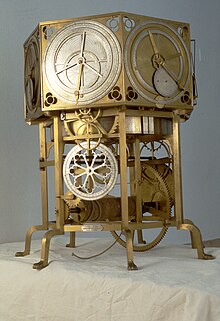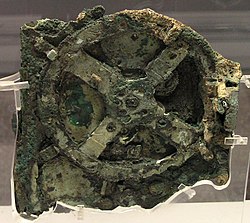Astrarium
The Astrarium was modeled after the solar system and, in addition to counting time and representing calendar dates and holidays, showed how the planets moved around the celestial sphere in one timepiece.
On May 17, 1902, an archaeologist named Valerios Stais discovered that a lump of oxidated material, which had been recovered from a shipwreck near the Greek island of Antikythera, held within it a mechanism with cogwheels.
[4] Extensive study of the fragments, using X-rays, has revealed enough details (gears, pinions, crank) to enable researchers to build partial replicas of the original device.
De' Dondi was inspired by his father Jacopo who designed the astronomical clock in the Piazzi dei Signori, Padua, in 1344 – one of the first of its type.
In modern times, the astrarium has grown into a tourist attraction as a commercially exploited planetarium-showing in IMAX theaters, with such presentations as The History of the Universe, as well as other astronomical phenomena.

